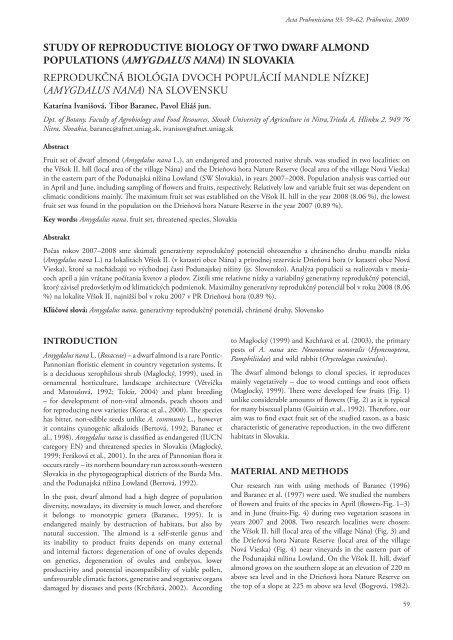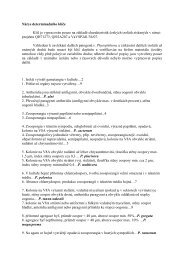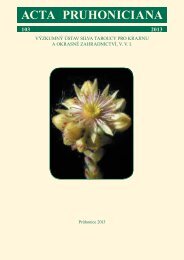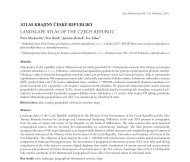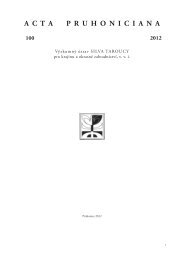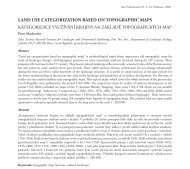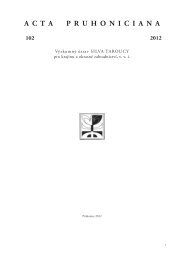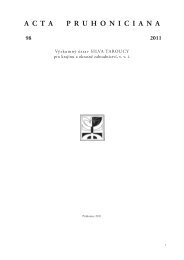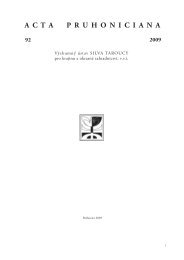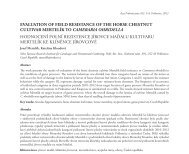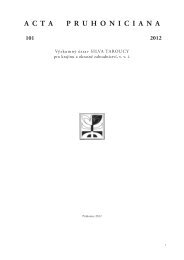Acta 93.indd - Výzkumný ústav Silva Taroucy pro krajinu a okrasné ...
Acta 93.indd - Výzkumný ústav Silva Taroucy pro krajinu a okrasné ...
Acta 93.indd - Výzkumný ústav Silva Taroucy pro krajinu a okrasné ...
You also want an ePaper? Increase the reach of your titles
YUMPU automatically turns print PDFs into web optimized ePapers that Google loves.
<strong>Acta</strong> Pruhoniciana 93: 59–62, Průhonice, 2009STUDY OF REPRODUCTIVE BIOLOGY OF TWO DWARF ALMONDPOPULATIONS (AMYGDALUS NANA) IN SLOVAKIAREPRODUKČNÁ BIOLÓGIA DVOCH POPULÁCIÍ MANDLE NÍZKEJ(AMYGDALUS NANA) NA SLOVENSKUKatarína Ivanišová, Tibor Baranec, Pavol Eliáš jun.Dpt. of Botany, Faculty of Agrobiology and Food Resources, Slovak University of Agriculture in Nitra,Trieda A. Hlinku 2, 949 76Nitra, Slovakia, baranec@afnet.uniag.sk, ivanisov@afnet.uniag.skAbstractFruit set of dwarf almond (Amygdalus nana L.), an endangered and <strong>pro</strong>tected native shrub, was studied in two localities: onthe Vŕšok II. hill (local area of the village Nána) and the Drieňová hora Nature Reserve (local area of the village Nová Vieska)in the eastern part of the Podunajská nížina Lowland (SW Slovakia), in years 2007–2008. Population analysis was carried outin April and June, including sampling of flowers and fruits, respectively. Relatively low and variable fruit set was dependent onclimatic conditions mainly. The maximum fruit set was established on the Vŕšok II. hill in the year 2008 (8.06 %), the lowestfruit set was found in the population on the Drieňová hora Nature Reserve in the year 2007 (0.89 %).Key words: Amygdalus nana, fruit set, threatened species, SlovakiaAbstraktPočas rokov 2007–2008 sme skúmali generatívny re<strong>pro</strong>dukčný potenciál ohrozeného a chráneného druhu mandľa nízka(Amygdalus nana L.) na lokalitách Vŕšok II. (v katastri obce Nána) a prírodnej rezervácie Drieňová hora (v katastri obce NováVieska), ktoré sa nachádzajú vo východnej časti Podunajskej nížiny (jz. Slovensko). Analýza populácií sa realizovala v mesiacochapríl a jún vrátane počítania kvetov a plodov. Zistili sme relatívne nízky a variabilný generatívny re<strong>pro</strong>dukčný potenciál,ktorý závisel predovšetkým od klimatických podmienok. Maximálny generatívny re<strong>pro</strong>dukčný potenciál bol v roku 2008 (8,06%) na lokalite Vŕšok II, najnižší bol v roku 2007 v PR Drieňová hora (0,89 %).Kľúčové slová: Amygdalus nana, generatívny re<strong>pro</strong>dukčný potenciál, chránené druhy, SlovenskoINTRODUCTIONAmygdalus nana L. (Rosaceae) – a dwarf almond is a rare Pontic-Pannonian floristic element in country vegetation systems. Itis a deciduous xerophilous shrub (Maglocký, 1999), used inornamental horticulture, landscape architecture (Větvičkaand Matoušová, 1992; Tokár, 2004) and plant breeding– for development of non-vital almonds, peach shoots andfor re<strong>pro</strong>ducing new varieties (Korac et al., 2000). The specieshas bitter, non-edible seeds unlike A. communis L., howeverit contains cyanogenic alkaloids (Bertová, 1992; Baranec etal., 1998). Amygdalus nana is classified as endangered (IUCNcategory EN) and threatened species in Slovakia (Maglocký,1999; Feráková et al., 2001). In the area of Pannonian flora itoccurs rarely – its northern boundary run across south-westernSlovakia in the phytogeographical districts of the Burda Mts.and the Podunajská nížina Lowland (Bertová, 1992).In the past, dwarf almond had a high degree of populationdiversity, nowadays, its diversity is much lower, and thereforeit belongs to monotypic genera (Baranec, 1995). It isendangered mainly by destruction of habitats, but also bynatural succession. The almond is a self-sterile genus andits inability to <strong>pro</strong>duct fruits depends on many externaland internal factors: degeneration of one of ovules dependson genetics, degeneration of ovules and embryos, lower<strong>pro</strong>ductivity and potential incompatibility of viable pollen,unfavourable climatic factors, generative and vegetative organsdamaged by diseases and pests (Krchňavá, 2002). Accordingto Maglocký (1999) and Krchňavá et al. (2003), the primarypests of A. nana are: Neurotoma nemoralis (Hymenoptera,Pamphiliidae) and wild rabbit (Oryctolagus cuniculus).The dwarf almond belongs to clonal species, it re<strong>pro</strong>ducesmainly vegetatively – due to wood cuttings and root offsets(Maglocký, 1999). There were developed few fruits (Fig. 1)unlike considerable amounts of flowers (Fig. 2) as it is typicalfor many bisexual plants (Guitián et al., 1992). Therefore, ouraim was to find exact fruit set of the studied taxon, as a basiccharacteristic of generative re<strong>pro</strong>duction, in the two differenthabitats in Slovakia.MATERIAL AND METHODSOur research ran with using methods of Baranec (1996)and Baranec et al. (1997) were used. We studied the numbersof flowers and fruits of the species in April (flowers-Fig. 1–3)and in June (fruits-Fig. 4) during two vegetation seasons inyears 2007 and 2008. Two research localities were chosen:the Vŕšok II. hill (local area of the village Nána) (Fig. 3) andthe Drieňová hora Nature Reserve (local area of the villageNová Vieska) (Fig. 4) near vineyards in the eastern part ofthe Podunajská nížina Lowland. On the Vŕšok II. hill, dwarfalmond grows on the southern slope at an elevation of 220 mabove sea level and in the Drieňová hora Nature Reserve onthe top of a slope at 225 m above sea level (Bogyová, 1982).59


